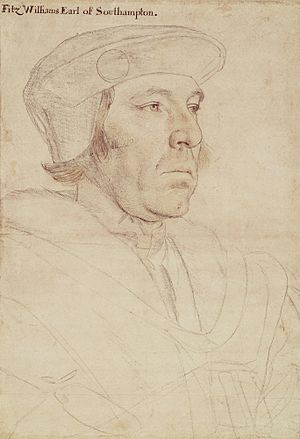William FitzWilliam, 1st Earl of Southampton facts for kids
Quick facts for kids
The Earl of Southampton
|
|
|---|---|

Portrait of William Fitzwilliam, Earl of Southampton, by Hans Holbein the Younger
|
|
| Treasurer of the Household | |
| In office 1525–1537 |
|
| Preceded by | Sir Thomas Boleyn |
| Succeeded by | Sir William Paulet |
| Personal details | |
| Born | c.1490 Aldwark, North Riding of Yorkshire |
| Died | October 15, 1542 Newcastle upon Tyne |
| Spouse | Mabel Clifford |
| Parents |
|
William FitzWilliam, the 1st Earl of Southampton, was an important English courtier and soldier. He was born around 1490 in Aldwark, Yorkshire. He passed away on October 15, 1542, in Newcastle upon Tyne.
William's father died when he was very young. His mother later married Sir Anthony Browne Sr. This made William the half-brother of Sir Anthony Browne Jr. Because of this family connection, William was chosen to be a friend and companion to Prince Henry Tudor. This prince later became King Henry VIII of England. William grew up right alongside the future king.
Contents
Early Life and Royal Service
After King Henry VIII became king in 1509, William FitzWilliam began to rise in the royal court. He was given roles like Gentleman Usher and King's Cupbearer. These jobs meant he was close to the King.
Starting a Military Career
William started his military career at sea. In 1512, he served under the Marquess of Dorset. He also served with Sir Edward Howard in a difficult attack on Brest, France. William was badly hurt by a crossbow bolt during this battle. However, he managed to survive.
He recovered quickly and joined King Henry VIII in France. He was knighted on September 25, 1513. This happened the day after the capture of Tournai. In November of that year, he married Mabel Clifford. They did not have any children.
Important Roles and Achievements
William FitzWilliam became well-known as a naval commander, a diplomat, and a government minister.
Protecting the Seas
As Vice-Admiral from 1513 to 1525, he spent a lot of time keeping the English Channel safe. He worked to clear the Channel of pirates. He also earned praise from Cardinal Wolsey for his actions against the French. In May 1522, England declared war on France.
William was made Vice-Admiral. He helped blockade the port of Brest. The English navy patrolled the coast of Brittany for three months. They worked with their Spanish allies. However, they could not win a major victory at sea.
Working as a Diplomat
Around 1521, William FitzWilliam served as an ambassador at the French court. Cardinal Wolsey noticed his skills. This showed that William was suitable for higher positions.
Joining the King's Council
In 1525, William FitzWilliam became the Treasurer of the Household. This important job gave him a seat on the King's Privy Council. This council helped the King make big decisions.
He was also made Captain of Guines in 1524. He stayed connected to Calais for the rest of his life. He helped create the Calais Act of 1536. He also played a big part in calming religious problems in Calais in the late 1530s. From 1529, he served as a member of parliament for Surrey. In 1537, he was given the title of Earl of Southampton.
Helping the King
William FitzWilliam often helped King Henry VIII with difficult situations. He was involved in events like the Pilgrimage of Grace. In 1539, as Admiral, he brought King Henry's future wife, Anne of Cleves, from Calais. When he first met her, he wrote good things about her to the King.
In autumn 1538, William and the Bishop of Ely questioned Margaret Pole, Countess of Salisbury. William held her prisoner until May 1539.
Later Life and Legacy
From 1540 until his death in 1542, William FitzWilliam served as the Lord Privy Seal. This was another very important role in the government. He also helped to stop arguments between different groups in Surrey.
In 1542, the Earl of Southampton was appointed to lead an expedition to Scotland. However, he was very sick at the time. He had to be carried to Newcastle upon Tyne in a special vehicle called a litter. He died in October, just three days after arriving there.
William FitzWilliam was buried in Newcastle. He had no children who could inherit his title. So, his title of Earl of Southampton ended when he died.
After his death, his half-brother, Sir Anthony Browne, inherited Cowdray House. William FitzWilliam had bought this house in 1529.
Images for kids


